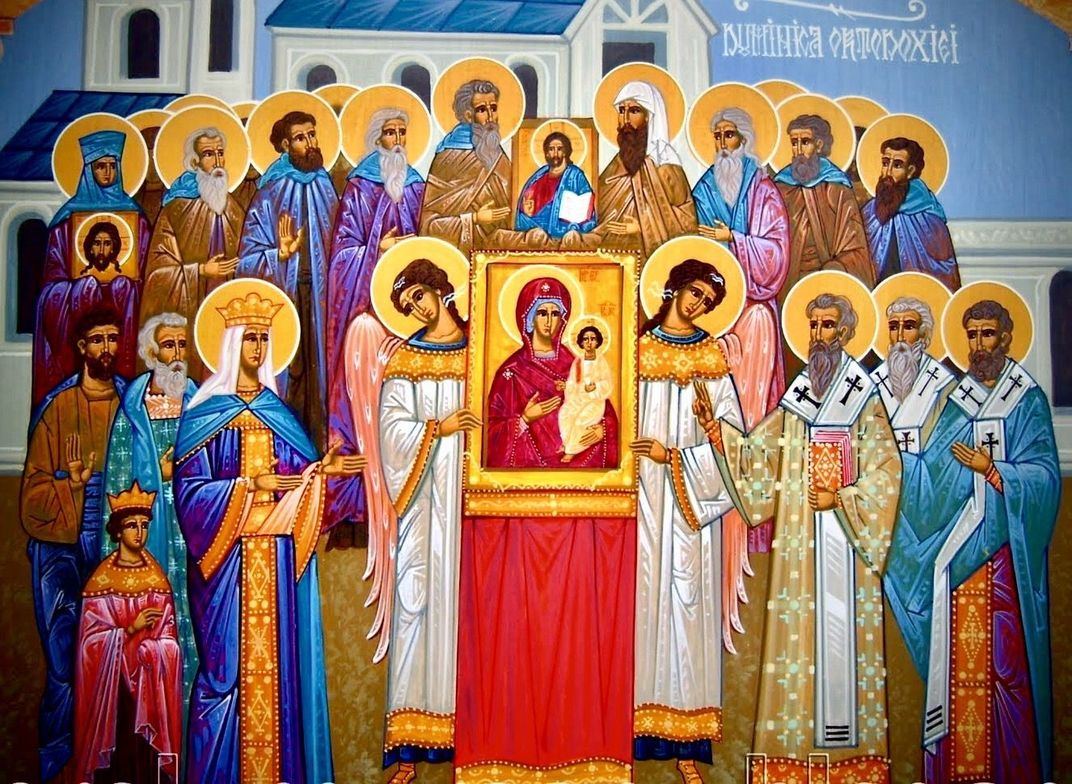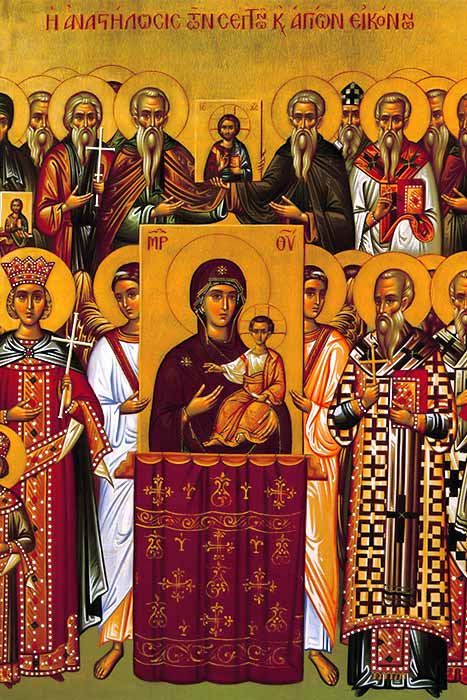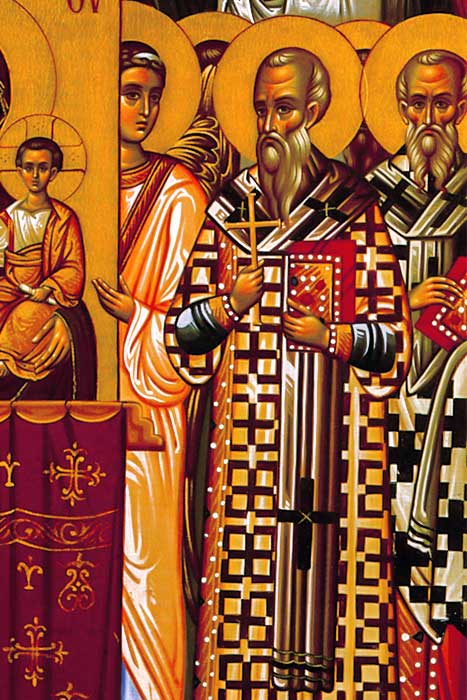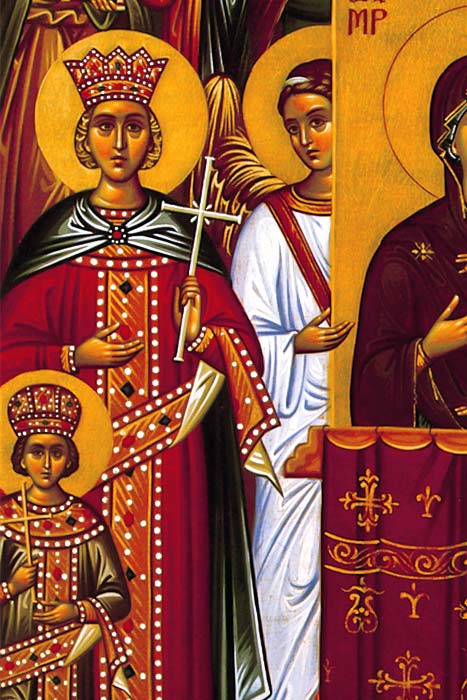Triumph of Orthodoxy Over the Iconoclasts Introduction The Sunday of Orthodoxy is the first Sunday of Great Lent. The dominant theme of this Sunday since 843 has been that of the victory of the icons. In that year the iconoclastic controversy, which had raged on and off since 726, was finally laid to rest, and icons and their veneration were restored on the first Sunday in Lent. Ever since, this Sunday has been commemorated as the "Triumph of Orthodoxy." Historical Background The Seventh Ecumenical Council dealt predominantly with the controversy regarding icons and their place in Orthodox worship. It was convened in Nicaea in 787 by Empress Irene at the request of Tarasios, Patriarch of Constantinople. The Council was attended by 367 bishops. Almost a century before this, the iconoclastic controversy had once more shaken the foundations of both Church and State in the Byzantine empire. Excessive religious respect and the ascribed miracles to icons by some members of society, approached the point of worship (due only to God) and idolatry. This instigated excesses at the other extreme by which icons were completely taken out of the liturgical life of the Church by the Iconoclasts. The Iconophiles, on the other-hand, believed that icons served to preserve the doctrinal teachings of the Church; they considered icons to be man's dynamic way of expressing the divine through art and beauty. The Council decided on a doctrine by which icons should be venerated but not worshipped. In answering the Empress' invitation to the Council, Pope Hadrian replied with a letter in which he also held the position of extending veneration to icons but not worship, the last befitting only God. The decree of the Council for restoring icons to churches added an important clause which still stands at the foundation of the rationale for using and venerating icons in the Orthodox Church to this very day: "We define that the holy icons, whether in color, mosaic, or some other material, should be exhibited in the holy churches of God, on the sacred vessels and liturgical vestments, on the walls, furnishings, and in houses and along the roads, namely the icons of our Lord God and Saviour Jesus Christ, that of our Lady the Theotokos, those of the venerable angels and those of all saintly people. Whenever these representations are contemplated, they will cause those who look at them to commemorate and love their prototype. We define also that they should be kissed and that they are an object of veneration and honor (timitiki proskynisis), but not of real worship (latreia), which is reserved for Him Who is the subject of our faith and is proper for the divine nature. The veneration accorded to an icon is in effect transmitted to the prototype; he who venerates the icon, venerated in it the reality for which it stands". An Endemousa (Regional) Synod was called in Constantinople in 843. Under Empress Theodora. The veneration of icons was solemnly proclaimed at the Hagia Sophia Cathedral. The Empress, her son Michael III, Patriarch Methodios, and monks and clergy came in procession and restored the icons in their rightful place. The day was called "Triumph of Orthodoxy." Since that time, this event is commemorated yearly with a special service on the first Sunday of Lent, the "Sunday of Orthodoxy". Orthodox teaching about icons, as defined at the Seventh Ecumenical Council of 787, is embodied in the texts sung on this Sunday. From Vespers: “Inspired by your Spirit, Lord, the prophets foretold your birth as a child incarnate of the Virgin. Nothing can contain or hold you; before the morning star you shone forth eternally from the spiritual womb of the Father. Yet you were to become like us and be seen by those on earth. At the prayers of those your prophets in your mercy reckon us fit to see your light, "for we praise your resurrection, holy and beyond speech. Infinite, Lord, as divine, in the last times you willed to become incarnate and so finite; for when you took on flesh you made all its properties your own. So we depict the form of your outward appearance and pay it relative respect, and so are moved to love you; and through it we receive the grace of healing, following the divine traditions of the apostles.” “The grace of truth has shone out, the things once foreshadowed now are revealed in perfection. See, the Church is decked with the embodied image of Christ, as with beauty not of this world, fulfilling the tent of witness, holding fast the Orthodox faith. For if we cling to the icon of him whom we worship, we shall not go astray. May those who do not so believe be covered with shame. For the image of him who became human is our glory: we venerate it, but do not worship it as God. Kissing it, we who believe cry out: O God, save your people, and bless your heritage.” “We have moved forward from unbelief to true faith, and have been enlightened by the light of knowledge. Let us then clap our hands like the psalmist, and offer praise and thanksgiving to God. And let us honor and venerate the holy icons of Christ, of his most pure Mother, and of all the saints, depicted on walls, panels and sacred vessels, setting aside the unbelievers' ungodly teaching. For the veneration given to the icon passes over, as Basil says, to its prototype. At the intercession of your spotless Mother, O Christ, and of all the saints, we pray you to grant us your great mercy. We venerate your icon, good Lord, asking forgiveness of our sins, O Christ our God. For you freely willed in the flesh to ascend the cross, to rescue from slavery to the enemy those whom you had formed. So we cry to you with thanksgiving: You have filled all things with joy, our Savior, by coming to save the world.” The name of this Sunday reflects the great significance which icons possess for the Orthodox Church. They are not optional devotional extras, but an integral part of Orthodox faith and devotion. They are held to be a necessary consequence of Christian faith in the incarnation of the Word of God, the Second Person of the Trinity, in Jesus Christ. They have a sacramental character, making present to the believer the person or event depicted on them. So the interior of Orthodox churches is often covered with icons painted on walls and domed roofs, and there is always an icon screen, or iconostasis, separating the sanctuary from the nave, often with several rows of icons. No Orthodox home is complete without an icon corner (iconostasion), where the family prays. Icons are venerated by burning lamps and candles in front of them, by the use of incense, and by kissing. But there is a clear doctrinal distinction between the veneration paid to icons and the worship due to God. The former is not only relative, it is in fact paid to the person represented by the icon. This distinction safeguards the veneration of icons from any charge of idolatry. The theme of the victory of the icons, by its emphasis on the incarnation, points us to the basic Christian truth that the one whose death and resurrection we celebrate at Easter was none other than the Word of God who became human in Jesus Christ. Before the Triumph of Orthodoxy came to be celebrated on the first Sunday of Lent, there was on this day a commemoration of Moses, Aaron, Samuel, and the prophets. Traces of this more ancient observance can still be seen in the choice of the Epistle reading at the Liturgy and in the Alleluia verse appointed before the Gospel: “ Moses and Aaron among His priests, and Samuel among them that call upon His Name.” Icon of the Feast The icon of the Sunday of Orthodoxy commemorates the “restoration” of icons in the churches and to their use in Orthodox worship. The focal point of the icon is an icon itself, the Virgin Hodegetria, a popular depiction of the Theotokos as “Directress,” or literally “She who shows the way to God.” The icon is carried by two angels. To the left of the icon is Empress Theodora and her son Michael III. To the right of the icon are the Patriarchs Methodios and Tarasios. The icon is surrounded by numerous saints who struggled against the Iconoclastic heresy. The icon also represents the triumphant procession that was made on Sunday, March 11, 843, from the Church of the Theotokos in Blachernai to Hagia Sophia, where a Liturgy was celebrated to mark the restoration of icons. Orthodox Christian Commemoration of the Sunday of OrthodoxyThe Sunday of Orthodoxy is commemorated with the Divine Liturgy of Saint Basil the Great, which is preceded by the Matins service. A Great Vespers is conducted on Saturday evening. The hymns of the Triodion for this day are added to the usual prayers and hymns of the weekly commemoration of the Resurrection of Christ. Scripture readings for the Sunday of Orthodoxy are: At the Orthros (Matins): The prescribed weekly Gospel reading. At the Divine Liturgy: Hebrews 11:24-26,32-40; John 1:43-51. At the conclusion of the Divine Liturgy, a service is conducted in commemoration of the affirmations of the Seventh Ecumenical Council in 787 and the restoration of the use of icons in 843. Orthodox faithful carry icons in a procession, while the clergy offer petitions for the people, civil authorities, and those who have reposed in the faith. Following is a reading of excerpts from the Affirmation of Faith of the Seventh Ecumenical Council and the singing of the Great Prokeimenon. It is becoming a common practice that the Procession of the Icons is conducted as part of a Pan-Orthodox Vespers service on the evening of the Sunday of Orthodoxy. This is a service when Orthodox Christians of the various jurisdictions in America come together for worship and in a united affirmation of the Truth of the Orthodox Faith. On the Saturday before this Sunday, the third of three Saturdays of the Souls are held. This is a special commemoration when the Church offers a Divine Liturgy and Memorial Service for the departed faithful. This is considered a universal commemoration of the dead. Through the memorial services, the Church is commending to God all who have departed and who are now awaiting the Last Judgment. This specific Saturday is a special commemoration of the Great Martyr Theodore of Tyre and the miracle of the kolyva. In 361, Julian the Apostate was doing his utmost to restore pagan customs. Knowing that the Christians were accustomed to sanctify the first week of Lent by fasting and prayer, the wily tyrant told the Prefect of Constantinople to have all of the food set out for sale in the markets sprinkled with the blood of animals sacrificed to the gods, so that no one in the city would escape the contagion of idolatry. However, the Lord did not abandon His chosen people, but sent His servant Theodore to outwit the tyrant. Appearing in a vision to Patriarch Eudoxius (360-364), the holy Martyr informed him of what was happening and told him to instruct the Christians not to buy food from the markets but instead to eat kolyva made from grains of boiled wheat. Thus, thanks to the intervention of the holy Martyr Theodore, the Christian people were preserved from the stain of idolatry. The Church has commemorated this miracle ever since on the first Saturday of Great Lent, in order to remind the faithful that fasting and temperance have the power to cleanse all the stains of sin. Hymns of the Feast Apolytikion (Tone Two) O Christ our God, begging forgiveness of our sins, we venerate your pure image O Good One. Of Your own will You condescended to ascend upon the Cross in the flesh and delivered those you created from the bondage of the enemy. Wherefore, thankfully we cry out: When You came to save the world You filled all things with joy, O our Savior. Kontakion (Plagal Fourth Tone) The undepictable Word of the Father became depictable when He took flesh of you, O Theotokos; and when He had restored the defiled image to its ancient state, He suffused it with divine beauty. As for us, confessing our salvation, we record it in deed and word.
0 Comments
Leave a Reply. |
AuthorArchives
October 2021
Categories |





 RSS Feed
RSS Feed